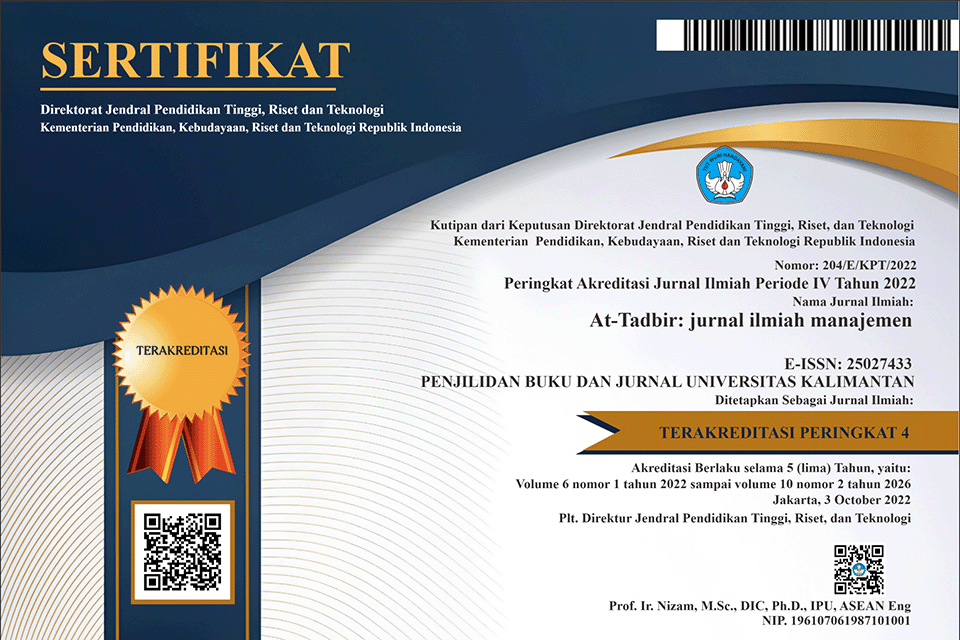Pengaruh E-Platform Aesthetics, E-Platform Responsiveness, E-Platform Ease of Use, dan E-Platform Information Quality Terhadap E-Customer Satisfaction Pada Pengguna Aplikasi Happy Fresh di Jakarta
(1) Sekolah Tinggi Pariwisata Trisakti
(2) Sekolah Tinggi Pariwisata Trisakti
(3) Sekolah Tinggi Pariwisata Trisakti
(4) Sekolah Tinggi Pariwisata Trisakti
(*) Corresponding Author
Abstract
Penelitian ini bertujuan untuk mengetahui pengaruh e-platform aesthetics, e-platform responsiveness, e-platform ease of use dan e-platform information quality terhadap e-customer satisfaction pada pengguna aplikasi Happy Fesh di Jakarta. Penelitian ini menggunakan pendekatan kuantitatif deskriptif. Ukuran sampel yang diambil sebanyak 108 orang, dengan teknik pengambilan sampel dengan metode sampel purposive sampling. Teknik pengumpulan data menggunakan kuesioner secara online. Metode yang digunakan dalam penelitian ini adalah metode regresi linear berganda dengan bantuan program SPSS. Hasil penelitian ini menunjukkan bahwa terdapat pengaruh signifikan e-platform aesthetics, e-platform responsiveness, e-platform ease of use dan e-platform information quality terhadap e-customer satisfaction. Aesthetic pada platform Happy Fresh memiliki aesthetic yang serasi dan senada ternyata dapat meningkatkan kepuasan pelanggan. Responsiveness pada platform Happy Fresh memandang responsiveness yang diberikan cepat, dan akurat sehingga mempengaruhi kepuasan pelanggan dengan layanan yang diterima pada platform Happy Fresh. Ease of use pada platform Happy Fresh memiliki kemudahan dalam penggunaan memberikan pengaruh terhadap kepuasan pelanggan. Information quality pada platform Happy Fresh memiliki kualitas informasi diperoleh dari platform Happy Fresh dapat mempengaruhi kepuasan pelanggan untuk melakukan pembelian secara online.
Full Text:
PDFReferences
Chong, A. Y. L. (2013). Mobile commerce usage activities: The roles of demographic and motivation variables. Technological Forecasting and Social Change, 80(7), 1350–1359. https://doi.org/10.1016/j.techfore.2012.12.011
Daeng, I. T. M., Mewenkang, N. N., & Kalesaran, E. R. (2017). Penggunaan Smartphone Dalam Menunjang Aktivitas
Perkuliahan Oleh Mahasiswa Fispol Unsrat Manado. E-Journal Acta Diurna, VI(1): 1-15.
Deng, L., & Poole, M. S. (2010). Affect in web interfaces: A study of the impacts of web page visual complexity and order. MIS Quarterly: Management Information Systems, 34(4), 711–730. https://doi.org/10.2307/25750702
Douneva, M., Thielsch, M. T., & Jaron, R. (2014). Effects of website design on first impressions, aesthetic judgments, and memory performance. Interacting with Computers, 28(2016), 552–567.
Gajewska, T., Zimon, D., Kaczor, G., & Madzík, P. (2020). The impact of the level of customer satisfaction on the quality of e-commerce services. International Journal of Productivity and Performance Management, 69(4), 666–684. https://doi.org/10.1108/IJPPM-01-2019-0018
George, A., & Kumar, G. S. G. (2014). Impact of service quality dimensions in internet banking on customer satisfaction. DECISION, 41(1), 73–85. https://doi.org/10.1007/s40622-014-0028-2
Ghasemaghaei, M., Hassanein, K., & Khaled, H. (2013). Consumers’ Satisfaction With Online Information Quality: The Moderating Roles Of Consumer Decision-Making Style, Gender And Product Involvement. In Gender And Product Involvement. http://aisel.aisnet.org/ecis2013_rip/10
Hair, et al., (2014). Multivariate Data Analysis, New International Edition., New Jersey : Pearson.
Han, F., & Li, B. (2020). Exploring the effect of an enhanced e-commerce institutional mechanism on online shopping intention in the context of e-commerce poverty alleviation. Information Technology and People, 18. https://doi.org/10.1108/ITP-12-2018-0568.
Hansen, J. M., Saridakis, G., & Benson, V. (2018). Risk, trust, and the interaction of perceived ease of use and behavioral control in predicting consumers’ use of social media for transactions. Computers in Human Behavior, 80, 197–206. https://doi.org/10.1016/j.chb.2017.11.010
Harris, L. C., & Goode, M. M. H. (2010). Online servicescapes, trust, and purchase intentions. Journal of Services Marketing, 24(3), 230–243. https://doi.org/10.1108/08876041011040631
Hernikawati, D. (2021). Analisa Dampak Pandemi Covid-19 Terhadap Jumlah Kunjungan Pada Situs E-Commerce di Indonesia Menggunakan Uji T Berpasangan. Jurnal Studi Komunikasi dan Media, 25(2): 191-202. DOI: 10.31445/jskm.2021.4389
Huang, Z., Luo, Y., & Wang, D. (2019). Online customer service quality of online shopping: evidence from Dangdang.com. Cluster Computing, 22, 15285–15293. https://doi.org/10.1007/s10586-018-2565-5
Kasmi., & Candra, A. N. (2017). Penerapan E-Commerce Berbasis Business To Consumers Untuk Meningkatan Penjualan Produk
Makanan Ringan Khas Pringsewu. Jurnal Aktual SRIE Trisna Negara, 15(2): 109-116. DOI: 10.47232/aktual.v15i2.27
Komara, A. T. (2013). Pengaruh E-Service Quality Dan E-Recovery Service Quality Terhadap E-Satisfaction Serta Implikasinya Pada E-Loyalty Pelanggan Maskapai Penerbangan Air Asia. Jurnal Ekonomi, Bisnis & Entrepreneurship Vol. 7, No. 2, 105-115
Kotler, Philip dan Gary Amstrong. (2018). Principles of Marketing. Edisi 15 Global Edition. Pearson
Laudon, Kenneth C. and Carol Guercio Traver. (2014). E-Commerce: Business, Technology & Society 10th edition. New Jersey: Pearson.
Lu, J. (2014). Are personal innovativeness and social influence critical to continue with mobile commerce? Internet Research, 24(2), 134–159. https://doi.org/10.1108/IntR-05-2012-0100
Norubha, A. K., & Rao, P. S. (2017). Effect of Website Quality on Customer Satisfaction and Purchase Intention in Online Travel Ticket Booking Websites. Management, 7(5), 168–173. https://doi.org/10.5923/j.mm.20170705.02
Nugraha, D. (2019). Toko Online di Indonesia, Sejarah dan Pengaruhnya. Diakses Pada 27 Januari, dari https://www.paper.id/blog/headline/toko-online-di-indonesia/
Oktora, S. I., & Mutasib, N. (2019). The Impact of Information and Communication Technology (ICT) on the Indonesian Apparel Export. Buletin Ilmiah Litbang Perdagangan, 13(1): 119-136. DOI:10.30908/bilp.v13i1.363
Poon, W. C., & Lee, C. K. C. (2012). E-Service Quality: An Empirical Investigation. Journal of Asia-Pacific Business, 13(3), 229–262. https://doi.org/10.1080/10599231.2012.690682
Pravasanti, Y. A., & Saputri, N. L. D. (2021). Keputusan Berbelanja Online di Masa Pandemi. Jurnal Budimas, 3(1): 209-213. DOI: http://dx.doi.org/10.29040/budimas.v3i1.2313
Pudjihardjo, M. C., & Wijaya, H. (2015). Pembelian Melalui Pemasaran Di Media Sosial (Studi Pada Pengguna Media Sosial Di Shapeharve). Jurnal Hospitality Dan Manajemen Jasa, 3(2), 361–379. http://publication.petra.ac.id/index.php/manajemen-perhotelan/article/view/3535
Rita, P., Oliveira, T., & Farisa, A. (2019). The impact of e-service quality and customer satisfaction on customer behavior in online shopping. Heliyon, 5(10), e02690. https://doi.org/10.1016/j.heliyon.2019.e02690
Sugiyono. (2017). Metode Penelitian Pendidikan: Pendekatan Kuantitatif, Kualitatif Dan R&D. Bandung: Alfabeta.
Thakur, R., & Srivastava, M. (2015). A study on the impact of consumer risk perception and innovativeness on online shopping in India. International Journal of Retail and Distribution Management, 43(2), 148–166. https://doi.org/10.1108/IJRDM-06-2013-0128
Zeithaml, V., Parasuraman, A. P., & Malhotra, A. (2002). Service Quality Delivery Through Web Sites: A Critical Review of Extant Knowledge. Journal of the Academy of Marketing Science, 30, 362–375.
DOI: http://dx.doi.org/10.31602/atd.v7i1.8657
Refbacks
- There are currently no refbacks.
Copyright (c) 2023 Andhalia Liza Marie, Linda Desafitri Ratu Bilqis, Mega Mulia Chandra, Mimi Enggriani
---------------------------------------------------------------------------------------------------------------------
At-Tadbir: Jurnal Ilmiah Manajemen is licensed under Creative Commons Attribution-Share A like 4.0 International License




